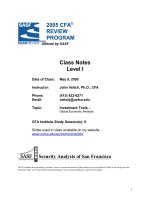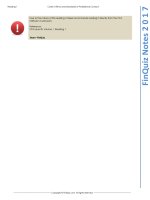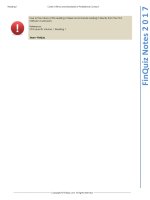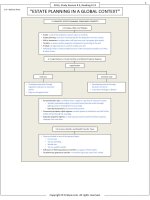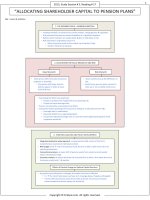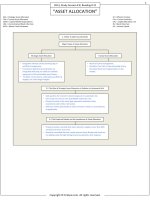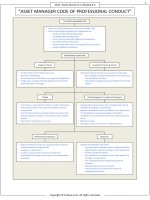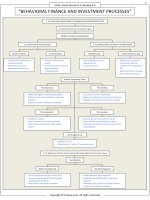FinQuiz smart summary, study session 6, reading 18
Bạn đang xem bản rút gọn của tài liệu. Xem và tải ngay bản đầy đủ của tài liệu tại đây (652.61 KB, 13 trang )
1
2013, Study Session # 6, Reading # 18
“CAPITAL MARKET EXPECTATIONS”
CMEs = Capital Market Expectations
2. ORGANIZING THE TASK: FRAMEWORK AND CHALLENGES
2.1 A Framework for Developing Capital Market Expectations
CMEs ⇒ β research (related to systematic risk).
CMEs:
Macro expectations ⇒ regarding asset classes.
Micro expectations ⇒regarding individual assets.
Process to formulate CMEs:
Specify CMEs needed according to investor’s tax status, allowable asset
classes & time horizon.
Research the historical record.
Identify the valuation model & its requirements.
Collect the best data possible.
Use experience & judgment to interpret current investment conditions.
Formulate CMEs & document conclusions.
Monitor actual outcomes & compare them to expectations & refined the
process if needed.
Good forecasts are unbiased, objective, well researched & efficient.
2.2 Challenges in Forecasting
Poor forecasts can result in inappropriate asset allocation.
Some problems in the use of data & analysts mistakes & biases are as follows.
2.2.1 Limitations of Economic Data
Time log b/w collection & distribution of data.
Revisions are not made at the time of publication.
Data definitions & methodology ∆ over time.
Data indices are often rebased over time.
2.2.2 Data Measurement Errors and Biases
Transcription Errors
Survivorship Bias
Errors in gathering & recording
data.
More problematic if biased in a
certain direction.
Data of surviving entities only.
Return series convey an overly
optimistic picture.
Appraisal (Smoothed/Data)
Appraisal data are used in lieu of
market price data for illiquid
assets.
Correlation & SD of the asset.
Potential solution ⇒ rescale the
data without effecting mean
return.
Copyright © FinQuiz.com. All rights reserved.
2
2013, Study Session # 6, Reading # 18
2.2.3 The Limitations of Historical Estimates
Past simply can’t be simply extrapolated to produce
future results.
Regime changes ⇒ ∆ in the technological, political
legal & regulatory environment (on stationary
data).
Statistical tools should be used to indentify regime
∆ or turning points.
Long Data Series
Statistical Necessity (Advantages)
Problems
Precisions with population parameters
are estimated.
Parameters (e.g. return, SD etc) are less
sensitive to time span.
Data may no longer be relevant.
Time series of required length may not be
available.
Asynchronous data if frequency is .
Test shorter time series of data should be used.
If data is non-stationary.
Regime ∆ deleted statistically.
2.2.4 Ex Post Risk Can Be a Biased Measure of Ex Ante Risk
Export data ⇒ after the fact, ex ante data ⇒ before the
fact.
Looking backward, analysts are likely to underestimate
ex ante risk & overestimate ex ant anticipated returns.
2.2.5 Biases in Analysts' Methods
Data-Mining Bias
Repeatedly searching a dataset until the
analyst finds some statistically significant
pattern.
To avoid the bias:
Find economic basis for the variable.
Test the discovered relationship with
out-of-sample data.
Time-Period Bias
Results from the time span of the data
chosen.
2.2.6 The Failure to Account for Conditioning Information
Relationship b/w security returns & economic variables
is not constant overtime.
Analyst should account for expected market condition in
their forecasts.
Copyright © FinQuiz.com. All rights reserved.
3
2013, Study Session # 6, Reading # 18
2.2.7 Misinterpretation of Correlations
The analyst should take care in interpreting correlations because:
Correlation may be spurious.
Endogenous variable may be unable to explain exogenous variable.
Correlation statistic missed the nonlinear relationship b/w two variables.
Multiple regressions (alternative to correlation) are used to uncover
predictive relationship.
Partial correlation is used for desired analysis.
2.2.8 Psychological Traps
Anchoring Trap
Status Quo Trap
Disproportionate weight to the 1st
information.
Solution ⇒ avoid premature conclusion.
Predict no change from the recent past.
To avoid cognitive cost or regret.
Solution ⇒ rational analysis within a decisionmaking process.
Confirming Evidence Trap
Overconfidence Trap
Greater weight to information that supports
an existing or preferred view.
To ensure objectivity:
Give all evidence equal scrutiny.
Seek out opposing opinions.
Be honest about your motives.
Overestimate the accuracy of forecasts.
Too narrow a range of scenarios in
forecasting.
Solution ⇒ wider the range of possibilities.
Prudence Trap
Recallability Trap
Overly conservative forecasts.
Stay close to the crowed (herding behavior).
Solution ⇒ wider the range of forecasted
values.
Too many weights to the events that left a
storing impression on a person’s memory.
Solution ⇒ conclusions on objective data.
2.2.9 Model Uncertainty
Model uncertainty ⇒ uncertainty concerning whether a selected model is
correct.
Input uncertainty ⇒ uncertainty concerning whether the inputs are correct.
Some analysts believe that market anomalies are results of different
valuation models.
Copyright © FinQuiz.com. All rights reserved.
4
2013, Study Session # 6, Reading # 18
3. TOOLS FOR FORMULATING CAPITAL MARKET EXPECTATIONS
3.1 Formal Tools
Tools that are accepted within the investment community.
3.1.1 Statistical Methods
3.1.1.1 Historical Statistical Approach: Sample Estimators20
Analyst use historical data for forecasting.
Project the historical mean, SD & correlations for a data set into the
future.
Decision point relates to the choice b/w AM & GM.
AM best represents the mean return in a single period.
GM repents the multi period growth.
For a risky variable GM
3.1.1.2 Shrinkage Estimators
Weighted avg of a historical estimate of a parameter & some other
parameters estimate.
Impact of historical extreme values.
Applied to mean return & covariance.
Efficiency of covariance if plausible target is selected.
3.1.1.3 Time-Series Estimators
3.1.1.4 Multifactor Models
Forecasting a variable using previous values of itself or other variables.
Variance clustering ⇒ high (low) volatility tend to follow high (low)
volatility.
J.P Morgan an model to measure current period volatility:
ଶ
ߪ௧ଶ = ߠߪ௧ିଵ
+ ሺ1 − ߠሻ߳௧ଶ
where
ߠ = rate of decay (between 0-1)
Explains the return to an asset in terms of the values of a set of risk
factors.
Useful for molding asset return & covariance’s.
Models usefulness:
When factors are well chosen, the model may filter out noise.
Common set of factors simplify the task of estimating covariance.
Verify covariance consistency.
3.1.2 Discounted Cash Row Models
DCF model ⇒ asset’s values is the present value of
future CF.
Advantage⇒ forward looking.
Disadvantages ⇒ don’t address current supply &
demand condition so not suitable for short-term
expectations.
Copyright © FinQuiz.com. All rights reserved.
5
2013, Study Session # 6, Reading # 18
Discounted CF Models
3.1.2.1 Equity Markets
Fixed-Income Markets
Gordon Growth Model
ܧሺܴ ሻ =
where
భ
బ
భ
బ
YTM of a reference bond in a segment
is used as expected return for the
segment.
Problem ⇒ YTM assumes
reinvestment at YTM.
Solution ⇒ use YTM of a zero coupon
bond.
+݃
= Dividend yield
g = growth (capital gains)
When applied at entire market level.
g = nominal GDP growth + excess
corporate growth.
Grin old & Kroner Model
ܧሺܴ ሻ ≈
భ
బ
Fed Model
− ∆ܵ + ݅ + ݃ + ∆ ܲൗܧ
Stock market is overvalued
(undervalued) is market’s E/P <(>) 10
year treasury bond yield.
where
-∆S = repurchase yield
i = expected inflation rate
g = expected real total earning growth
∆P/E = par period change in P/E
multiple.
Three components:
Expected income return: D/P -∆S
Expected nominal earning
growth = i+g expected capital
gains.
Expected reprising return ∆ P/E
expected capital gains.
3.1.3 The Risk Premium Approach
3.1.3.2 Fixed-Income Premiums
3.1.3.3 The Equity Risk Premium
ܧሺܴ ሻ = Real Rf rate + inflation premium + default risk
premium + illiquidity premium + maturity premium + tax
premium.
Equity risk premium ⇒ compensation required for the
additional risk of equity.
Bond yield plus risk premium approach ⇒ ܧሺܴ ሻ = YTM on
longer term govt bond + equity risk premium.
3.1.4 Financial Market Equilibrium Models
Describe relationship b/w E(R) & risk in which
supply & demand are in balance.
Copyright © FinQuiz.com. All rights reserved.
6
2013, Study Session # 6, Reading # 18
Equilibrium Models
The ICAPM Approach
Singer-Terhaar Approach
If PPP holds then:
ܧሺܴ ሻ = ܴ + ߚ ൫ܧሺܴ ሻ − ܴ ൯
where
ܧሺܴ ሻ = return on global investable market.
ߚ = asset’s sensitivity to the return on the
world market portfolio.
Asset class’s risk premium
Account for two market imperfections.
Illiquidity
Market segmentation.
Illiquidity premiums can be estimated through
investment’s multi period sharpe ratio(MPSR)
Investment’s MPSR should at least be as
high as MPSR.
Steps of singer-Tehaar approach:
Estimate perfectly integrated &
segmented risk premiums.
Add the illiquidity premiums.
Estimate the degree of market
integration.
Weighted avg of completely integrated &
segmented market.
Calculate the expected returns ⇒ ܴ +
ܴ .
ܴ = ߪ ߩ, ቀ
ோ
ఙ
ቁ
3.2 Survey and Panel Methods
Survey method ⇒ asking a group of experts for their
expectations & using the responses in CME.
Pane method ⇒ group pooled is fairly constant over time.
Equity risk premium expectations of practitioners are
consistently more optimistic than that of academies.
3.3 Judgment
Economic & psychological insights to improve forecasts.
Investors may use checklists.
4. ECONOMIC ANALYSIS
Assets with lower (higher) expected payoffs during business
cycle ⇒ higher (lower) risk premiums.
Points of inflection in economic activity provide unique
investment opportunities.
Economic growth has two components:
Trend growth (use in longer tem CME).
Cyclical growth (important for short-term CME).
Copyright © FinQuiz.com. All rights reserved.
7
2013, Study Session # 6, Reading # 18
4.1 Business Cycle Analysis
Two cycles:
Inventory cycle (2-4 years).
Business cycle (9-11 years).
Chief measures of economic activity:
GDP
Output Gap ⇒ difference b/w actual GDP & trend.
Recession ⇒ two successive quarterly in GDP.
4.1.1 The Inventory Cycle
Usually judged through inventory/sales ratio:
When this ratio has moved down (up) ⇒ economy is
likely to be strong (weak) in next few months.
Overall this indicator has been trending down ⇒
improved techniques.
4.1.2 The Business Cycle
Initial Recovery
Early Upswing
Economy picks up form recession.
Business confidence .
Inflation.
Bond yield .
Stock prices .
Economy gains momentum.
Consumer confidence.
Short term rates & longer term bond yield are .
Stocks are trending .
Late Upswing
Slowdown
Economy is in the danger of overheating.
Confidence, unemployment.
Interest rates & bond yields are .
Equities are volatile.
Confidence start wavers.
Inflation continues to rise.
Short term IR are high & bond yield curve
inverts.
Stock market may .
Recession
Inventories pull back.
Unemployment, inflation & confidence.
Short term IR & bond yields .
Stock markets start to rise in the later stage.
Copyright © FinQuiz.com. All rights reserved.
2013, Study Session # 6, Reading # 18
4.1.3 Inflation and Deflation in the Business Cycle
Inflation tend to rise in later stages of cycle & to during recession &
early stages of recovery.
Three principles of central banks to deal with inflation:
Decision making must be independent of political influence.
Inflation target.
Use monetary policy to control economic growth (inflation).
Deflation is a threat:
It tends to undermine debt-financed investments.
Central bank is unable to stimulate economy by further IR
(already in bottom).
Bonds outperform during recession.
Rising inflation is good for equities unless the central bank tends to IR.
4.1.4 Market Expectations and the Business Cycle
Business cycle phases are difficult to identify & predict
(CME difficult to form).
4.1.5 Evaluating Factors that Affect the Business Cycle
Business cycle analysis should be focused on:
Consumer spending (major part of GDP).
Business (small part of GDP out volatile).
Foreign trade.
Govt activity (monetary policy & fiscal policy).
The Taylor Rule
Links b/w target short-term IR to the rate of economic growth & inflation.
Prescriptive tool & fairly accurate at predicting central bank action.
ݎ௧௧ =
ܴ݊݁ ݈ܽݎݐݑ+ 0.5൫ܲܦܩ௦௧ௗ − ܲܦܩ௧ௗ ൯ +
5൫݂݈݅݊ܽ݊݅ݐ௦௧ௗ ݂݈݅݊ܽ݊݅ݐ௧௧ ൯
When IR are at zero, further monetary stimulus requires new type of
measures:
More cash into the banking system.
Currency devaluations.
Low short term IR for an extended period.
Buy asset directly from the private sector.
4.1.5.4 Fiscal Policy
Govt ( ) spending or ( ) taxes to stimulate (slow) the economy.
Two $ points should be kept in mind:
It is ∆ in deficit that matter not the level of deficit.
Only deliberate changes in fiscal policy matters.
Copyright © FinQuiz.com. All rights reserved.
8
2013, Study Session # 6, Reading # 18
The Yield Curve
Expansionary fiscal & monetary policy ⇒ steeply upward
sloping Y.C.
Restrictive monetary & fiscal policy ⇒ inverted Y.C.
Expansionary monetary & restrictive fiscal policy ⇒
moderately upward sloping Y.C.
Expansionary fiscal & restrictive monetary policy⇒ flat Y.C.
4.2 Economic Growth Trends
Long term growth path GDP.
Shocks in trends are difficult to forecast.
Trend rate, equity returns.
4.2.1 Consumer Impacts: Consumption and Demand
Consumer spending is quite stable over business cycle.
Permanent income hypothesis ⇒ consumer spending
behavior is largely determined by long run income
expectations.
4.2.2 A Decomposition of GDP Growth and Its Use in Forecasting
Aggregate trend growth is the sum of the following:
Changes in employment
Growth in potential labour force size.
Growth in actual labour force participation rate.
Changes in labour productivity:
Growth from capital inputs.
Growth in total factor productivity.
If investment is growing faster than returns, returns on
invested capital are driven down.
4.2.3 Government Structural Policies
Policies that affect the limits of economic growth & incentives
with in a private sector.
Elements of structural policy:
Sound fiscal policy ⇒ stimulate economy through
budget deficits three problems:
It brings current A/C deficit.
Inflation
Take resources from private sector.
Low government intervention.
Competition within the private sector is encouraged.
Sound tax policies.
Copyright © FinQuiz.com. All rights reserved.
9
10
2013, Study Session # 6, Reading # 18
4.3 Exogenous Shocks
Unanticipated events that occur outside the normal course of
an economy.
These shocks usually produce a negative impact on the
economy & not built into prices.
Types of Economic Shocks
4.3.1 Oil Shocks
4.3.2 Financial Crises
Oil prices, inflation, growth.
Oil prices, inflation, growth.
Significant oil prices, overheated
economy, inflation.
Affect growth through bank leading
or investor confidence.
More dangerous in low IR
environment.
4.4 International Interactions
4.4.1 Macroeconomic Linkages
4.4.2 Interest Rate/Exchange Rate Linkages
Business cycle in one country can affect that
in others.
Even economies of developed countries are
not perfectly integrated.
Some countries unilaterally peg their
currencies to one of the major currencies.
Pegging strategy has two benefits:
Currency volatility is reduced.
Inflation can be brought under control.
4.4.3 Emerging Markets
4.4.3.1 Essential Differences between Emerging and Major Economies
Emerging countries:
Rely heavily on foreign capital.
Have volatile political & social environment.
Need major structural reform.
Rely on commodities.
4.4.3.2 Country Risk Analysis
Emerging bond investors ⇒ focus on default risk.
Emerging stock investors ⇒ evaluate growth
prospects.
Investors should ask the following question before
investing in EM:
How sound is fiscal & monetary policy?
ி௦ௗ௧
ீ
< 4%݅)݁ݐܽ݅ݎݎܽݏ.
What are the economic growth prospects of
the economy (growth rate > 4% is
appropriate).
Is the currency competitive, & are external
accounts under control? (deficit > 4% of GDP is
uncompetitive).
It external debt under control? (ratio of foreign
debt GDP A/C receipts > 200% is dangerous).
Is liquidity plentiful? ቀ
௦௩௦௦௧
௧ௗ௧
<
100%݅ݏݑݎ݁݃݊ܽ݀ݏቁ.
Is the political situation supportive of the required
policies?
Copyright © FinQuiz.com. All rights reserved.
11
2013, Study Session # 6, Reading # 18
4.5 Economic Forecasting
Approach of Economic Forecasting
Econometric Models
Leading Indicators
Formals & mathematical approach to
forecasting.
Variable found to lead turns in the
economy.
Checklists
Subjective integration of the answers to
a set of questions.
4.5.1 Econometric Modeling
Definition
Benefit
Application of quantitative molding &
analysis.
Can be reused.
Prices quantitative forecasts.
Limitations
Complex & time taking.
Variables may also be measured with
error.
4.5.2 Economic Indicators
Definition
Advantages
Contain information on an economy’s
recent past activity or its current or
future positions in business cycle.
Available from outside parties.
Easy to understand & interpret.
Adapted for specific purposes.
Verified by academic research.
Disadvantages
Not consistently accurate.
Forecasts can be misleading.
4.5.3 Checklist Approach
Definition
Advantages
Check off a list of questions that should
indicate the future growth of the
economy.
Flexible
Simple
Disadvantages
Require subjective judgment.
Time intensive to create.
4.6 Using Economic Information in Forecasting Asset Class Returns
4.6.1 Cash and Equivalents
Short term debt with maturity of a year or less.
Longer maturity & less credit worthy instruments have
expected return & risk.
In order to outperform, manager must be able to forecast
future rates better than other managers.
Copyright © FinQuiz.com. All rights reserved.
12
2013, Study Session # 6, Reading # 18
4.6.2 Nominal Default-Free Bonds
Default free bonds issued by govt in developed countries.
Yield on these bonds:
Real yield
Expected inflation
Stronger eco growth ⇒ bond yields ( demand for capital & inflation).
Changes in short term IR have less predictable effects on bond yield.
in short term rates ⇒ longer term bond’s yield (but if economy slows as
result of in IR then yield ).
4.6.3 Defaultable Debt
Debt with credit risk (particularly corporal debt).
During recession (expansion) spread tend to widen (narrow).
4.6.4 Emerging Market Bonds
Debt of non-developed countries.
Emerging countries usually borrow in foreign currency, so the
risk of default is higher.
4.6.5 Inflation-Indexed Bunds
Yield on inflation indexed bonds changes over time with three
economic factors:
Strong economy ( real yields), real yields on TIPS will be
higher.
Supply & demand may also effect yields on TIPS.
Yields fall if inflation accelerates.
4.6.6 Common Shares
4.6.6.1 Economic Factors Affecting Earnings
4.6.6.2 The PIE Ratio and the Business Cycle
4.6.6.3 Emerging Market Equities
The trend growth rate, the avg
earnings growth.
Defensive stocks receive market
valuation while cyclical stocks receive
valuation during recession.
A P/E rate tends to be during early
stages of a recovery.
Molodovsky effect ⇒ P/Es of cyclical
companies may be than their own
historical means during downturns
(investors anticipates a sharp future
earnings).
Inflation rates tend to depress P/E
ratios.
Equity risk premiums for
emerging markets are on average
higher & more volatile than
developed markets.
4.6.7 Real Estate
Determinates of real estate returns ⇒
consumption growth, real IR, term structure of IR
& unexpected inflation.
Low IR are positive for real estate valuation.
Copyright © FinQuiz.com. All rights reserved.
2013, Study Session # 6, Reading # 18
4.6.8 Currencies
Imports, economic growth &
IR, currency will depreciates.
4.6.9 Approaches to Forecasting Exchange Rates
4.6.9.1 Purchasing Power Parity
4.6.9.2 Relative Economic Strength
Exchange rate differential = inflation differential.
Does not hold in short or medium term.
Focus on investment flows rather than trade flows.
Strong economic growth, currency demand,
currency appreciation.
Short-term deposit rates, capital moves in to the
country, currency appreciation.
This approach tells nothing about level of exchange
rates.
4.6.9.3 Capital Flows
4.6.9.4 Savings-Investment Imbalances
Particularly equity investment & foreign direct
investment (FDI).
FDI inflows, currency tends to appreciates.
Capital flows may reverse the usual relationship b/w IR
& currency.
During expansion, if domestic savings are < investments
then foreign borrowings (appreciate domestic currency
to attract foreign capital).
If investments < savings then currency will deprecates.
4.6.10 Government Intervention
Govt face three challenges when try to influence exchange
rates:
Foreign exchange trading value > foreign exchange
reserves.
Exchange rates are determined by fundamentals (govt
is just another player).
Foreign exchange trends control is not encouraging in
the absence of capital control.
Copyright © FinQuiz.com. All rights reserved.
13
